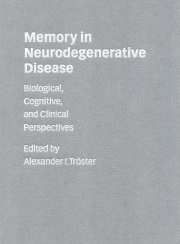Book contents
- Frontmatter
- Contents
- List of contributors
- Preface
- PART I Biological perspectives
- 1 Nonhuman primate models of memory dysfunction in neurodegenerative disease: contributions from comparative neuropsychology
- 2 Nonprimate animal models of motor and cognitive dysfunction associated with Huntington's disease
- 3 Neuropathology and memory dysfunction in neurodegenerative disease
- 4 Neurochemical aspects of memory dysfunction in neurodegenerative disease
- 5 Structural neuroimaging correlates of memory dysfunction in neurodegenerative disease
- 6 Functional neuroimaging correlates of memory dysfunction in neurodegenerative disease
- 7 The biology of neurodegenerative disease
- PART II Cognitive perspectives
- PART III Clinical perspectives
- Index
2 - Nonprimate animal models of motor and cognitive dysfunction associated with Huntington's disease
from PART I - Biological perspectives
Published online by Cambridge University Press: 23 November 2009
- Frontmatter
- Contents
- List of contributors
- Preface
- PART I Biological perspectives
- 1 Nonhuman primate models of memory dysfunction in neurodegenerative disease: contributions from comparative neuropsychology
- 2 Nonprimate animal models of motor and cognitive dysfunction associated with Huntington's disease
- 3 Neuropathology and memory dysfunction in neurodegenerative disease
- 4 Neurochemical aspects of memory dysfunction in neurodegenerative disease
- 5 Structural neuroimaging correlates of memory dysfunction in neurodegenerative disease
- 6 Functional neuroimaging correlates of memory dysfunction in neurodegenerative disease
- 7 The biology of neurodegenerative disease
- PART II Cognitive perspectives
- PART III Clinical perspectives
- Index
Summary
INTRODUCTION
The purpose of this chapter is to present the neuropathological, neurochemical and neuroanatomical substrates of Huntington's disease (HD) followed by a discussion of the extant animal models aimed at mimicking the neuropathological, neurochemical and neuroanatomical characteristics of this disease. Then, the neurological, behavioral and cognitive dysfunctions of HD are reviewed, and this review is followed by a discussion of possible parallel functions associated with models of caudate dysfunction aimed at mimicking the neurological, behavioral and cognitive characteristics of HD. Unfortunately, there is a paucity of studies that have examined cognitive dysfunction in the best models of HD. Thus, in order to determine whether the caudate in animals, especially the rat, mediates motor and cognitive functions that parallel similar caudate mediated functions in humans, the patterns of motor and cognitive deficits in animals with caudate dysfunction induced by multiple means will be described. To the extent that there are caudate mediated parallels in motor and cognitive functions between animals and humans, there would be a greater impetus to study in more detail the cognitive dysfunctions of animal models of HD.
NEUROPATHOLOGICAL FEATURES OF HUNTINGTON'S DISEASE
At a macroscopic level, the primary area of pathology in HD is the head of the caudate nucleus and, to a lesser extent, the putamen (see also Chapter 3). In a large scale postmortem study, Vonsattel et al. (1985) found that the dorsomedial aspects of the caudate appear to be the locus of greatest cell loss in this structure with the ventrolateral aspects of this nucleus becoming more affected as the disease progresses.
Information
- Type
- Chapter
- Information
- Memory in Neurodegenerative DiseaseBiological, Cognitive, and Clinical Perspectives, pp. 21 - 35Publisher: Cambridge University PressPrint publication year: 1998
Accessibility standard: Unknown
Why this information is here
This section outlines the accessibility features of this content - including support for screen readers, full keyboard navigation and high-contrast display options. This may not be relevant for you.Accessibility Information
- 1
- Cited by
